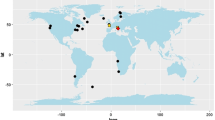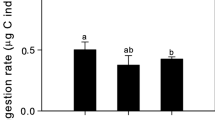Abstract
The copepod Temora stylifera was fed with the pennate diatom Pseudo-nitzschia delicatissima for 15 days. This diatom does not produce polyunsaturated aldehydes (PUAs) but only synthesizes other oxylipins such as the hydroxyacid (5Z,8Z,11Z,13E,15S,17Z)-15-hydroxy-5,8,11,13,17-eicosapentaenoic acid (15S-HEPE). Effects of this monoalgal diet were compared to copepods fed with the PUA-producing diatom Skeletonema marinoi and the control dinoflagellate Prorocentrum minimum which does not produce any oxylipins. Both egg production and hatching success were negatively affected by the two diatoms compared to the control diet. Both diatoms also induced malformations in the offspring, with the number of malformed nauplii increasing dramatically with time. Malformed nauplii were apoptotic (TUNEL-positive) indicating imminent death. In terms of recruitment, only 4 healthy nauplii female−1 day−1 with S. marinoi and 9 healthy nauplii female−1 day−1 with P. delicatissima were produced during the 15-day experimental period. The results indicate that P. delicatissima induced negative effects comparable to those of S. marinoi even though it did not produce PUAs. This is the first study that tests the biological activity of oxylipins other than PUAs on copepod reproduction.





Similar content being viewed by others
References
Adolph, S., S. A. Poulet & G. Pohnert, 2003. Synthesis and biological activity of α,β,γ,δ-unsaturated aldehydes from diatoms. Tetrahedron 59: 3003–3008.
Andreou, A., F. Brodhun & I. Feussner, 2009. Biosynthesis of oxylipins in non-mammals. Progress in Lipid Research 48: 148–170.
Ban, S. H., C. Burns, J. Castel, Y. Chaudron, E. Christou, R. Escribano, S. F. Umani, S. Gasparini, F. G. Ruiz, M. Hoffmeyer, A. Ianora, H. K. Kang, M. Laabir, A. Lacoste, A. Miralto, X. R. Ning, S. Poulet, V. Rodriguez, J. Runge, J. X. Shi, M. Starr, S. Uye & Y. J. Wang, 1997. The paradox of diatom–copepod interactions. Marine Ecology Progress Series 157: 287–293.
Buttino, I., G. De Rosa, Y. Carotenuto, M. Mazzaella, A. Ianora, F. Esposito, V. Vitiello, F. Quaglia, M. I. La Rotonda & A. Miralto, 2008. Aldehyde-encapsulating liposomes impair marine grazer survivorship. Journal of Experimental Biology 211: 1426–1433.
Caldwell, G. S., 2009. The influence of bioactive oxylipins from marine diatoms on invertebrate reproduction and development. Marine Drugs 7: 367–400.
Casotti, R., S. Mazza, C. Brunet, V. Vantrepotte, A. Ianora & A. Miralto, 2005. Growth inhibition and toxicity of the diatom aldehyde 2-trans, 4-trans-decadienal on Thalassiosira weissflogii (Bacillariophyceae). Journal of Phycology 41: 7–20.
Ceballos, S. & A. Ianora, 2003. Different diatoms induce contrasting effects on the reproductive success of the copepod Temora stylifera. Journal of Experimental Marine Biology & Ecology 294: 189–202.
d’Ippolito, G., A. Cutignano, R. Briante, F. Febbraio, G. Cimino & A. Fontana, 2005. New C-16 fatty-acid-based oxylipin pathway in the marine diatom Thalassiosira rotula. Organic & Biomolecular Chemistry 3: 4065–4070.
d’Ippolito, G., N. Lamari, M. Montresor, G. Romano, A. Cutignano, A. Gerecht, G. Cimino G. & A. Fontana, 2009. 15S-LOX metabolism in the marine diatom Pseudo-nitzschia delicatissima. New Phytologist 183:1064–1071.
Dutz, J., M. Koski & S. H. Jonasdottir, 2008. Copepod reproduction is unaffected by diatom aldehydes or lipid composition. Limnology & Oceanography 53: 225–235.
Fink, P., E. Von Elert & F. Jüttner, 2006. Oxylipins from freshwater diatoms act as attractants for a benthic herbivore. Archiv für Hydrobiologie 167: 561–574.
Flynn, K. J. & X. Irigoien, 2009. Aldehyde-induced insidious effects cannot be considered as a diatom defence mechanism against copepods. Marine Ecology Progress Series 377: 79–89.
Fontana, A., G. d’Ippolito, A. Cutignano, G. Romano, N. Lamari, A. Massa Gallucci, G. Cimino, A. Miralto & A. Ianora, 2007. LOX-induced lipid peroxidation mechanism responsible for the detrimental effect of marine diatoms on zooplankton grazers. ChemBioChem 8: 1810–1818.
Guillard, R. R. L. & J. H. Ryther, 1962. Studies of marine plankton diatoms: I. Cyclotella nana Husted and Detonula confervacea (Cleve) Gran. Journal of Microbiology 8: 229–239.
Halsband-Lenk, C., J. J. Pierson & A. W. Leising, 2005. Reproduction of Pseudocalanus newmani (Copepoda: Calanoida) is deleteriously affected by diatom blooms – a field study. Progress in Oceanography 67: 332–348.
Ianora, A. & A. Miralto, 2010. Toxigenic effects of diatoms on grazers, phytoplankton and other microbes: a review. Ecotoxicology 19(3):493–511.
Ianora, A., B. Scotto di Carlo & P. Mascellaro, 1989. Reproductive biology of the copepod Temora stylifera. Marine Biology 101: 187–194.
Ianora, A., S. Poulet & A. Miralto, 2003. The effects of diatoms on copepod reproduction: a review. Phycologia 42: 351–363.
Ianora, A., A. Miralto, S. A. Poulet, Y. Carotenuto, I. Buttino, G. Romano, R. Casotti, G. Pohnert, T. Wichard, L. Colucci-D’Amato, G. Terrazzano & V. Smetacek, 2004. Aldehyde suppression of copepod recruitment in blooms of a ubiquitous planktonic diatom. Nature 429: 403–407.
Ianora, A., R. Casotti, M. Bastianini, C. Brunet, G. d’Ippolito, F. Acri, A. Fontana, A. Cutignano, J. T. Turner & A. Miralto, 2008. Low reproductive success for copepods during a bloom of the non-aldehyde-producing diatom Cerataulina elagica in the North Adriatic Sea. Marine Ecology 29: 399–410.
Juttner, F., 2005. Evidence that polyunsaturated aldehydes of diatoms are repellents for pelagic crustacean grazers. Aquatic Ecology 39: 271–282.
Keller, M. D., R. C. Selvin, W. Claus & R. R. L. Guillard, 1987. Media for the culture of oceanic ultraphytoplankton. Journal of Phycology 13: 638–663.
Miralto, A., G. Barone, G. Romano, S. A. Poulet, A. Ianora, G. L. Russo, I. Buttino, G. Mazzarella, M. Laabir, M. Cabrini & M. G. Giacobbe, 1999. The insidious effect of diatoms on copepod reproduction. Nature 402: 173–176.
Pohnert, G., 2005. Diatom/copepod interactions in plankton: the indirect chemical defense of unicellular algae. Chemistry and Biochemistry 6: 946–959.
Pohnert, G., O. Lumineau, A. Cueff, S. Adolph, C. Cordevant, M. Lange & S. Poulet, 2002. Are volatile unsaturated aldehydes from diatoms the main line of chemical defence against copepods? Marine Ecology Progress Series 245: 33–45.
Poulet, S. A., M. Laabir, A. Ianora & A. Miralto, 1995. Reproductive response of Calanus helgolandicus.1. Abnormal embryonic and naupliar development. Marine Ecology Progress Series 129: 85–95.
Ribalet, F., J. A. Berges, A. Ianora & R. Casotti, 2007a. Growth inhibition of cultured marine phytoplankton by toxic algal-derived polyunsaturated aldehydes. Aquatic Toxicology 85: 219–227.
Ribalet, F., T. Wichard, G. Pohnert, A. Ianora, A. Miralto & R. Casotti, 2007b. Age and nutrient limitation enhance polyunsaturated aldehyde production in marine diatoms. Phytochemistry 68: 2059–2067.
Taylor, R. L., K. Abrahamsson, A. Godhe & S.-Å. Wängberg, 2009. Seasonal variability in polyunsaturated aldehyde production potential among strains of Skeletonema marinoi (Bacillariophiceae). Journal of Phycology 45: 46–53.
Uye, S., 1996. Induction of reproductive failure in the planktonic copepod Calanus pacificus by diatoms. Marine Ecology Progress Series 133: 89–97.
Vardi, A., F. Formiggini, R. Casotti, A. De Martino, F. Ribalet, A. Miralto & C. Bowler, 2006. A stress surveillance system based on calcium and nitric oxide in marine diatoms. PLoS Biology 4: 1–9.
Vardi, A., K. Bidle, C. Kwityn, D. J. Hirsh, S. M. Thompson, J. A. Callow, P. Falkowski & C. Bowler, 2008. A diatom gene regulating nitric-oxide signaling and susceptibility to diatom-derived aldehydes. Current Biology 18: 895–899.
Vargas, C. A., R. Escribano & S. Poulet, 2006. Phytoplankton food quality determines time windows for successful zooplankton reproductive pulses. Ecology 87: 2992–2999.
Vidoudez, C. & G. Pohnert, 2008. Growth phase-specific release of polyunsaturated aldehydes by the diatom Skeletonema marinoi. Journal of Plankton Research 30: 1305–1313.
Vos, M., L. E. M. Vet, F. L. Wackers, J. J. Middelburg, W. H. van der Putten, W. M. Mooij, C. R. R. Heip & E. van Donk, 2006. Infochemicals structure marine, terrestrial and freshwater food webs: implications for ecological informatics. Ecological Informatics 1: 23–32.
Wendel, T. & F. Juttner, 1996. Lipoxygenase-mediated formation of hydrocarbons and unsaturated aldehydes in freshwater diatoms. Phytochemistry 41: 1445–1449.
Wichard, T., S. A. Poulet, C. Halsband-Lenk, A. Albaina, R. Harris, D. Liu & G. Pohnert, 2005. Survey of the chemical defence potential of diatoms: screening of fifty one species for α,β,γ,δ-unsaturated aldehydes. Journal of Chemical Ecology 31: 949–958.
Wichard, T., S. A. Poulet, A.-L. Boulesteix, J. B. Ledoux, B. Lebreton, J. Marchetti & G. Pohnert, 2008. Influence of diatoms on copepod reproduction. II. Uncorrelated effects of diatom-derived a,b,c,d-unsaturated aldehydes and polyunsaturated fatty acids on Calanus helgolandicus in the field. Progress in Oceanography 77: 30–44.
Author information
Authors and Affiliations
Corresponding author
Additional information
Guest editors: J.-S. Hwang and K. Martens / Zooplankton Behavior and Ecology
Rights and permissions
About this article
Cite this article
Ianora, A., Romano, G., Carotenuto, Y. et al. Impact of the diatom oxylipin 15S-HEPE on the reproductive success of the copepod Temora stylifera . Hydrobiologia 666, 265–275 (2011). https://doi.org/10.1007/s10750-010-0420-7
Published:
Issue Date:
DOI: https://doi.org/10.1007/s10750-010-0420-7




